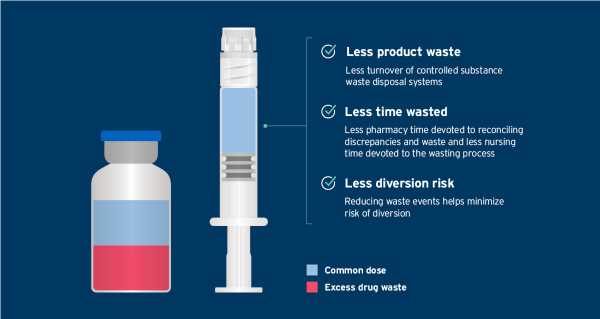
Controlled substances including fentanyl, hydromorphone and morphine can play an important role in clinical care. But with such high potential for abuse, it’s essential that healthcare organizations find ways to minimize product waste to promote patient safety and reduce unnecessary costs.1 Michele A. Sheaffer, Associate Director of Pharmacy Operations at Jefferson Abington Hospital in Pennsylvania, said she and her colleagues are constantly looking for opportunities to streamline operational processes, including the way they handle controlled substances.
After seeing Fresenius Kabi give a presentation about Simplist® products at a conference, Sheaffer said she was intrigued by the idea of optimizing dosages to manufacturer pre-filled pharmaceutical products to minimize waste transactions. She appreciated the company’s waste analysis, which, using Abington’s own data, showed her that using smaller presentations of ready-to-administer products could help reduce waste events by 95% for hydromorphone and by 52% for fentanyl.
“It was eye-opening for us to look at our own data and see that if we converted just one drug to a ready-to-administer product in a smaller presentation, we could reduce our waste transactions by close to 9,000 in a single year. That’s a huge savings in terms of cost, as well as in nursing time and resources,” Sheaffer pointed out.
“In the past, we didn’t necessarily look at how many waste transactions were occurring. But as part of my work with our drug diversion committee, we have been looking for new ways to improve our diversion deterrence and decrease opportunities for waste,” she said. “We really wanted to find ways to start collecting data and to make positive changes – and also to convert those improvements into cost savings.”
By making that switch, Sheaffer said that they have already seen a decrease in the number of total waste transactions. That saves money on drug purchasing and inventory – but it also translates into saving valuable time for both pharmacy and nursing staff.
“Every time a nurse needs to waste a medication, they need a witness to complete the waste transaction which may lead to interruptions and impede patient care time,” she said. “If a waste transaction isn’t closed for some reason, a nurse manager has to spend time figuring out what happened so they can close it – and that’s extra time they could be spending elsewhere. Reducing our waste results in a significant time savings.”
And, Sheaffer added, having this kind of analysis at their disposal is also helping them with their goal of reducing opportunities for drug diversion across the facility and streamlining nursing workflow to afford them additional time with patients.
“Each waste event brings with it the possibility of diversion,” she said. “The Fresenius Kabi team made it very easy for us to make these changes. They looked at our data and provided recommendations about product sizes and the different doses available. They identified areas where we could make improvements to reduce our controlled substance waste. In doing so, we are in a better position to deter someone from diverting these drugs. It’s something that, ultimately, is going to keep both our patients and our employees safer.”
Reference
3675-FNCI-08-01/23
Source: Read Full Article
